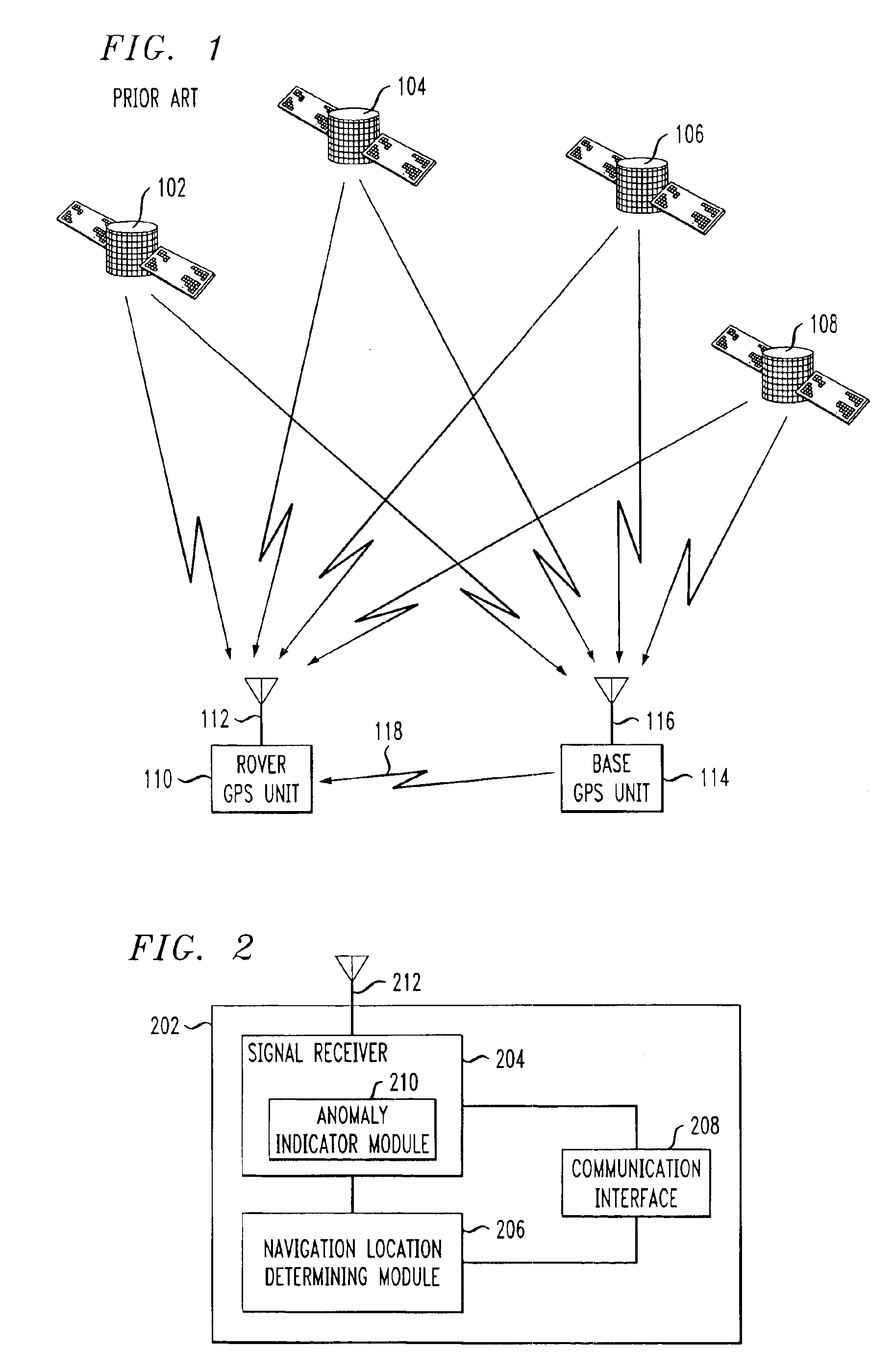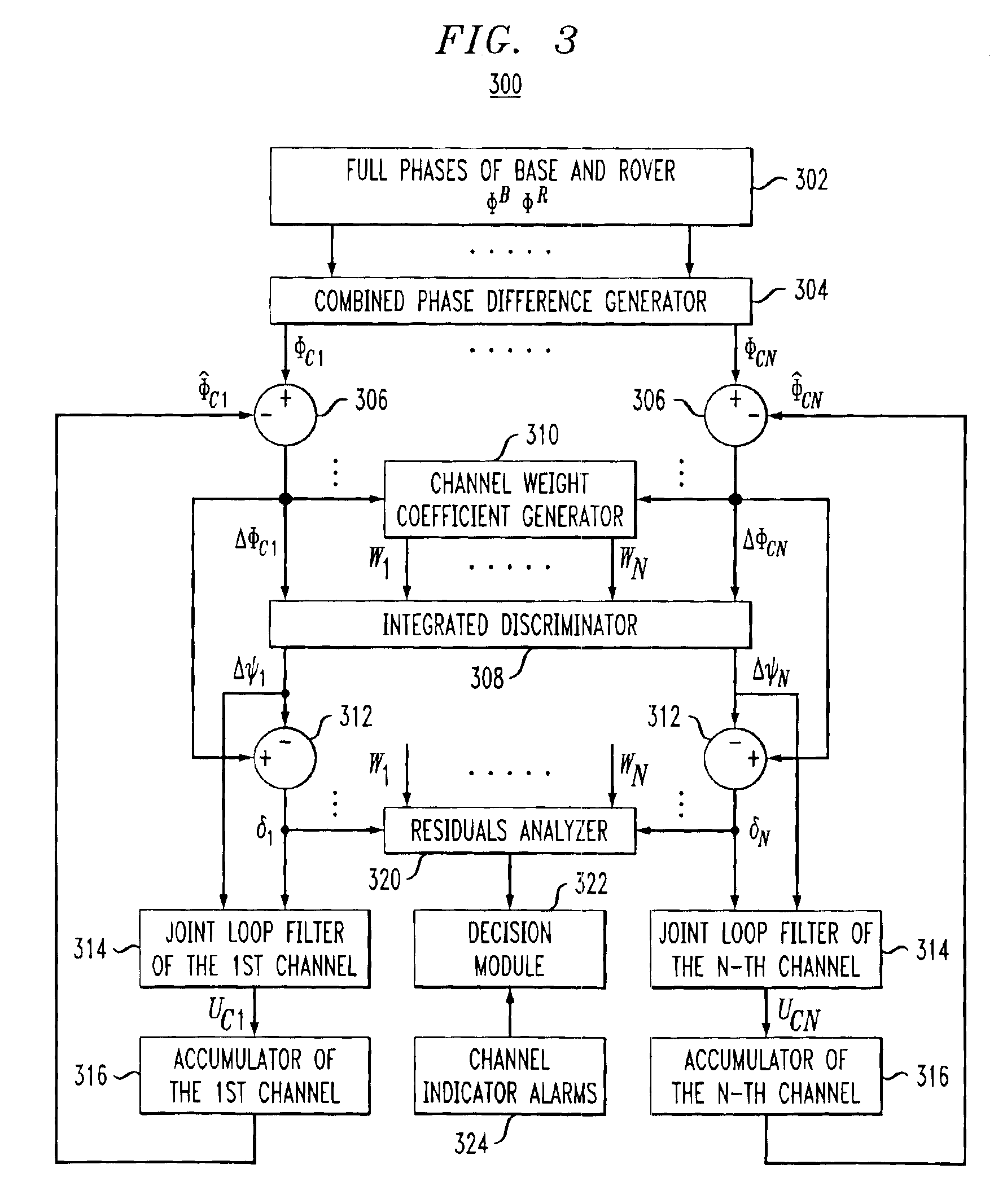Method and apparatus for detecting anomalous measurements in a satellite navigation receiver
a satellite navigation and anomalous measurement technology, applied in the field of satellite navigation receivers, can solve the problems of ambiguity resolution, the difference in the phase delay of a carrier signal received by the base and rover receivers may substantially exceed one cycle, and it is not possible to measure the integer number of cycles from the incoming satellite signal, so as to increase the accuracy of a navigation task
- Summary
- Abstract
- Description
- Claims
- Application Information
AI Technical Summary
Benefits of technology
Problems solved by technology
Method used
Image
Examples
first embodiment
FIG. 3 shows a functional block diagram of an anomaly indicator module 300 which utilizes a feedback loop. FIG. 3 only shows details for channels 1 and N since the processing of all channels is the same. Function blocks which are common to all channels are also shown. It is noted that the functional block diagrams (e.g., FIGS. 2-6) herein are meant to describe high level functioning of a unit. One skilled in the art would readily recognize that some of the blocks represent input parameters, others represent output parameters, while others represent some function or operation. The functions and operations may be performed by hardware circuits, software instructions executing on a processor, or some combination of hardware and software. Given the description herein, those skilled in the art would be able to implement the described functionality using various combinations of hardware and software. As such, implementation details of the functions described herein will not be described i...
second embodiment
the residual analyzer is based upon verifying the so-called criterion χ2 in which a weighted sum of residual squares is compared to the threshold. In this embodiment, the weighted sum is calculated according to equation (11): χ2=∑j=1nwj(δj)2,(11)
where wj is the weight coefficient of the j-th channel as shown above, n is the number of remaining channels (i.e., n will be equal to N at the outset, and may be reduced as a result of eliminating channels from the phase mismatch calculation as described above). If the phase mismatches ΔΦcj are normal random values independent in different channels, then the weighted sum of residual squares χ2 has distribution according to χ2-law with (n−2) degree of freedom. The corresponding distribution (χ2-law) may be determined by well known techniques. Based on the probability distribution law one can determine the threshold πz to which the value χ2 is to be compared to result in a relatively small acceptable probability of false alarm. For example,...
third embodiment
the residual analyzer is also based on criteria χ2, but locates the channel with the anomalous measurement in a different way. Once the threshold has been exceeded, it is assumed that an anomalous measurement exists in one channel only and the channels are eliminated one by one. However, upon eliminating a particular channel and recalculating χ2, if the threshold remains exceeded using the remaining n=N−1 channels, then the particular channel is returned to the set of channels used in the calculation of χ2 and a second channel is eliminated. Again, χ2 is recalculated with the remaining n=N−1 channels. A first search continues in this manner until either the one channel having the anomalous measurement is found, or after eliminating all channels and the threshold continuing to be exceeded, it is determined that more than one channel has an anomalous measurement. In the latter case, a second search is initiated now eliminating channel pairs and computing χ2 using n=N−2 channels. A sec...
PUM
 Login to View More
Login to View More Abstract
Description
Claims
Application Information
 Login to View More
Login to View More - R&D
- Intellectual Property
- Life Sciences
- Materials
- Tech Scout
- Unparalleled Data Quality
- Higher Quality Content
- 60% Fewer Hallucinations
Browse by: Latest US Patents, China's latest patents, Technical Efficacy Thesaurus, Application Domain, Technology Topic, Popular Technical Reports.
© 2025 PatSnap. All rights reserved.Legal|Privacy policy|Modern Slavery Act Transparency Statement|Sitemap|About US| Contact US: help@patsnap.com



